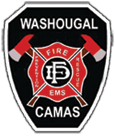Ambulance History
1935- The Camas Volunteer Fire Department began a basic first aid ambulance service with volunteers. The service extended east into Skamania County and west into what is now Cascade Park. The Department acquired the first medical "aid car" in the State of Washington, a 1931 Lincoln sedan, equipped with an E.&J. inhalator-resuscitator. The ambulance responded to 47 calls in the first year. No other service was available in the area.
1959 - The City Council voted to discontinue the aid car service, citing the existence of a private ambulance company and the age of the aid car.
1962 - After a committee review, a new aid car was purchased and the Fire Department aid car service was resumed.
1970 - The Fire Department acquired a 1970 "Superior Cadillac Rescuer Ambulance" containing "the latest and most modern life support equipment".
1972 - Ambulance service was upgraded to the basic life support level with higher trained volunteers. Call volume was at an annual rate of 428.
1975- The first modular type ambulance was purchased. There were 563 ambulance calls that year.
1978- Service was upgraded to advanced life support with higher trained volunteers. There were 660 ambulance calls.
1979 - A program to provide Advanced Life Support (ALS) Paramedic ambulance service to the east Clark County area was studied. Voters supported the concept, approving a $0.25/1,000 assessed valuation property tax to support the program. There were 688 ambulance calls, 50% occured outside the city limits of Camas.
1980- The East County Paramedic Service was formed, covering the cities of Camas and Washougal, and Fire Districts 1 and 9. The service area covered about 100 sq. miles. Four paramedics were hired, with one paramedic on-duty 24 hours per day. Volunteers served as drivers. There were 831 ambulance calls.
1983- Following the EMS Levy renewal, the fifth paramedic was hired, still one paramedic was on-duty at a time. There were 850 ambulance calls.
1987- There were 1,160 ambulance calls, reliance on volunteer drivers was becoming problematic and other options were explored.
1988- The EMS Levy was renewed by voters with 84% in favor. The sixth paramedic was hired, two paramedics were available part of the time. There were 1,169 ambulance calls. Off-duty career firefighters, called in from home, began serving as drivers.
1990- The seventh paramedic was hired. With the addition of on-duty firefighters serving as ambulance drivers, the immediate response of the ambulance was assured. There were 1,308 ambulance calls.
1991- The eighth paramedic was hired and two paramedics on-duty 24 hours per day became the standard. There were 1,399 ambulance calls, 202 required more than one ambulance simultaneously.
1993- Implementation of Firefighter/Paramedic and cross-training of paramedics was completed. There were 1,930 ambulance calls, 267 required more than one ambulance simultaneously.
1994- The EMS Levy was renewed. A ninth paramedic was hired to maintain service levels.
1997- Six additional cross-trained Firefighter/Paramedics were hired to staff a second, west fire station. With the completion of their basic training, three ambulances were available, utilizing on-duty staffing.
1999- A new ambulance was purchased and an older one retained as a fourth, reserve ambulance, assuring 3 available ambulances when one is being serviced.
2000- Camas Ambulance responded to 2,257 medical calls. A historical, but difficult to serve, area west of 192nd Avenue was relinquished to a private ambulance provider on the recommendation of the county medical program director.


